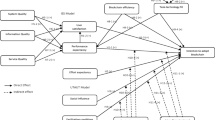Abstract
Cartel stability is investigated in a context of adverse selection whereconsumers are imperfectly informed about product quality. Producer collusionmay be necessary to signal quality via third-party certification. Whileexamining different cost structures for third-party certification, we showthat a stable cartel that provides information about product quality mayimprove overall welfare even if producers collude to reduce competition.
Similar content being viewed by others
References
Akerlof, G. (1970) ‘The Market for Lemons: Quality Uncertainty and the Market Mechanism’, Quarterly Journal of Economics, 84(1), 488–500.
Bagwell, K., and M. Riordan (1991) ‘High and Declining Prices Signal Product Quality’, American Economic Review, 81, 224–239.
Boeckem, S. (1998) ‘Small Heterogeneous Cartel’, Journal of Institutional and Theoretical Economics, 154, 572–588.
Bourgeon, J., and B. Coestier (1996) Private Versus Public Product Labeling, Thema, Université Paris X Nanterre.
Caswell, J., and E. Mojduszka (1996) ‘Using Informational Labeling to Influence the Market for Quality in Food Products’, American Journal of Agricultural Economics, 78, 1248–1253.
Crampes, C., and A. Hollander (1995) ‘How Many Carats is Gold? Welfare Effects of Easing a Denomination Standard’, Journal of Regulatory Economics, 7, 131–143.
Darby, M., and E. Karni (1973) ‘Free Competition and the Optimal Amount of Fraud’, Journal of Law and Economics, 16, 67–88.
d’Aspremont, C., A. Jacquemin, J. Gabzewicz, and J. Weymark (1983) ‘On the Stability of Collusive Price Leadership’, Canadian Journal of Economics, 25, 17–25.
De, S., and P. Naber (1991) ‘Economic Implications of Imperfect Quality Certification’, Economic Letters, 37, 333–337.
Economist (1996) ‘Product Testing’, The Economist, 90–91.
Economist (1996) ‘Sticky Labels’, The Economist, 89–80.
EEC (1992) European Economic Community, Directives No. 2081/92 and No. 2082/92 (1.208), Brussels, Belgium.
Hollander, A., S. Monier, and H. Ossard (1999) ‘Pleasures of Cockaigne: Quality Gap, Market Structure, and the Amount of Grading’, American Journal of Agricultural Economics, 81, 353–365.
Marette, S., J. Crespi, and A. Schiavina (1999) ‘The Role of Common Labelling in a Context of Asymmetric Information’, European Review of Agricultural Economics, 26, 167–178.
Martin, S. (1993) Advanced Industrial Economics, Basil Blackwell.
Mason, C. and F. Sterbenz (1994) ‘Imperfect Product Testing and Market Size’, International Economic Review, 35, 61–86.
Milgrom, P., and J. Roberts (1986) ‘Price and Advertising Signals of Product Quality’, Journal of Political Economy, 94, 796–821.
Mussa, M., and S. Rosen (1978) ‘Monopoly and Product Quality’, Journal of Economic Theory, 18, 301–317.
NCFC (1997) National Council of Farmer Cooperatives, Washington D.C. http://www.access.digex.net
Nelson, P. (1970) ‘Information and Consumer Behavior’, Journal of Political Economy 78, 311–329.
Neven, D., P. Papandropoulos, and P. Seabright (1999) Trawling for Minnows: European Competition Policy and Agreements between Firms, CEPR, London.
Prokop, J. (1999) ‘Process of Dominant-Cartel Formation’, International Journal of Industrial Organisation, 17, 241–257.
Schmitt, N. and R. Weder (1998) ‘Sunk Costs and Cartels Formation’, Journal of Economic Behavior and Organization, 36, 195–217.
Sexton, R. (1986) ‘Cooperatives and the Forces Shaping Agricultural Markets’, American Journal of Agricultural Economics, 68, 1167–1172.
Shaffer, S. (1995) ‘Stable Cartels with a Cournot Fringe’, Southern Economic Journal, 61, 744–754.
Spulber, D. (1989) Regulation and Markets, MIT Press.
Stigler, G. (1950) ‘Monopoly and Oligopoly by Mergers’, American Economic Review, 40, 23–34.
Stigler, G. (1964) ‘A Theory of Oligopoly’, Journal of Political Economy, 72, 44–61.
Sunkist (1997) ‘Sunkist Growers. http://www.sunkist.com, Van Nuys, CA.
Symeonidis, G. (1999) ‘Cartel Stability in Advertising-Intensive and RandD-Intensive Industries’, Economic Letters, 62, 121–129.
Thoron, S. (1998) ‘Formation of a Coalition-Proof Stable Cartel’, Canadian Journal of Economics, 30, 63–75.
Tirole, J. (1996) ‘A Theory of Collective Reputations’, The Review of Economic Studies, 1–32.
US (1966) US v. Grinnel Corporation, 384 U.S. Supreme Court 563, Washington D.C.
USDA (1999) United States Department of Agricultural Economics, Washington D.C. http://www.usda.com
Wilson, C. (1980) ‘The Nature of Equilibrium with Adverse Selection’, The Bell Journal of Economics, 11, 108–130.
Wolinsky, A. (1983) ‘Prices as Signals of Product Quality’, The Review of Economic Studies, 50.
Author information
Authors and Affiliations
Rights and permissions
About this article
Cite this article
Marette, S., Crespi, J.M. Can Quality Certification Lead to Stable Cartels?. Review of Industrial Organization 23, 43–64 (2003). https://doi.org/10.1023/B:REIO.0000005595.35570.1a
Issue Date:
DOI: https://doi.org/10.1023/B:REIO.0000005595.35570.1a




